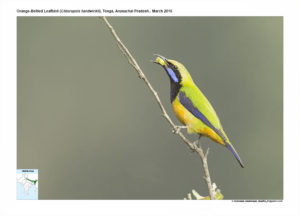Orange-bellied Leafbird

Orange-bellied Leafbird Chloropsis hardwickii
Etymology:
- Chloropsis: Greek word khlros – green; opsis-
- Hardwicki : Named after Britis naturalist Thomas Hardwicke (1756–1835)
Vernacular names: Cachar: Dao-gurrum ho gatang
Distribution in India: Resident of Himalayas and North East India.
Description: Size of 15–19·8 cm; wt. of male 32–40 g, female 25–34 g. The Male nominate race has full black mask from lores and eye, extending to form broad bib down to upper breast, enclosing large jawline flash of shining violet-blue; anterior cap and narrow border around rest of mask subdued bronzy yellow; lesser wing-coverts out to carpal joint brilliant electric blue, other coverts, flight-feathers and tail deep black with dark purplish-blue edges; remaining upperparts grass-green; underparts below bib tawny-orange, upper flanks sharply demarcated green; iris dark brown; bill black; feet pale grey. Female has full yellow eyelid rim, duller jaw flash than male, smaller area of electric blue on wing, orange belly and vent, rest of plumage grass-green. The juvenile is entirely grass-green, apart from yellow eyelid rim.
Habitat: It is found in canopy and edge of deciduous to evergreen forests, and secondary growth. It breeds between 600 m and 2000 m.
Food Habits: It eats arthropods, fruits and nectar. Gleans outer foliage and flowers for caterpillars, spiders and other arthropods, and chases winged termites, moths and butterflies and other insects Fruits include figs and berries; small fruit items eaten directly, but medium-sized, tough-coated items are pierced, and the contents then loosened and squeezed out by using the bill. During nectar hunting often behaves acrobatically as they reach and probe into deep tubular corollas for nectar. Individuals may patrol and defend a foraging patch.
Breeding Habits: They breed in May-Aug in India. It builds a shallow, open cup-nest of fine fibrous materials, sparsely lined and rarely with any external decoration, supported hammock-like at rim between thin twigs towards outer end of upper branch. They lay a clutch of 2 -3 eggs. The incubation period is 13 days and fledging period is 12 days.